World War 2030s. With what atomic sub-melt we will enter it
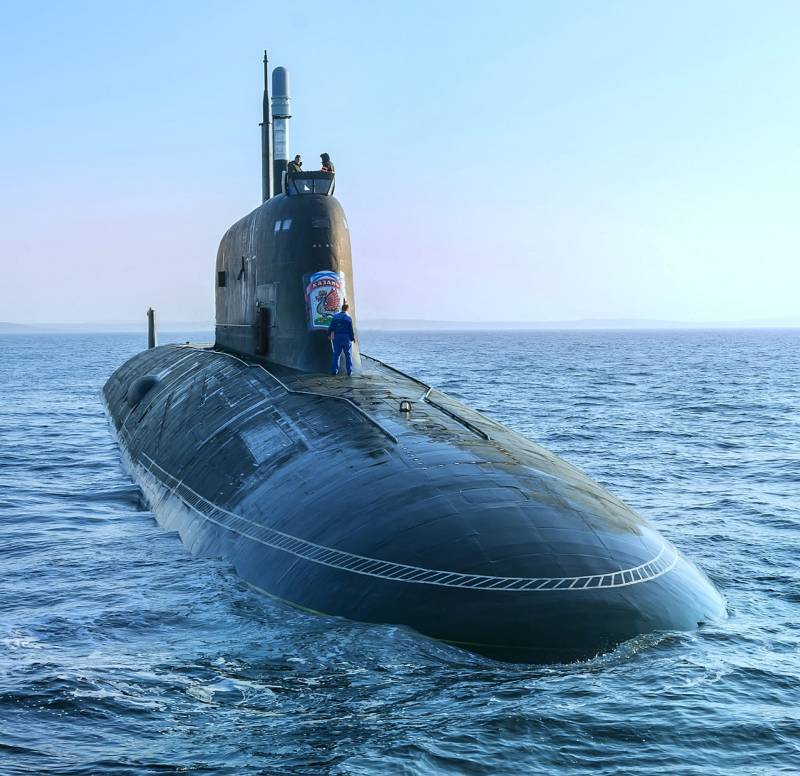
Yaseni-M never had a chance for a large series because of the price, besides, they have a lot of shortcomings. In the photo - "Kazan". Source: press service of PJSC "Northern Machine-Building Enterprise"
The growing risk of American (or Anglo-American) nuclear aggression, the growing threat of which said in a previous article, makes us conduct an audit of our forces, especially since we can roughly guess at what time frame everything can start - by about 2030 and for about, again, a five-year period after.
There, either China is over, or the United States, or the problems with American dominance in the world will somehow be resolved, and the reasons for the war will be significantly less "out of the blue." The war, if it does happen, is most likely in the indicated years (again, approximately) or it will be transferred to an unpredictably distant historical perspective.
Therefore, we need not just a revision of forces, but a revision of the realistic composition of forces for 2030.
First of all, it will be about the Navy.
Forecasting the state of the Navy as a branch of the armed forces is an immense topic. And even a simple analysis of a promising ship composition - too. An attempt to fulfill this was at one time undertaken by another author in a series of articles Russian Navy. A sad look into the future "... A summary analysis and forecast of the ship composition was made in the last article of the series, which can be viewed here... Today it is impossible not to say that Andrey's conclusions turned out to be overly optimistic, everything will be completely different, and this is obvious.
I would like, of course, to also go through all the classes, but, alas, even the updated anti-mine forces are useless without strike and anti-submarine ships and submarines. Therefore, for a start, it makes sense to limit ourselves to combat ships capable of solving tasks in the Far Sea Zone, because they will be needed to thwart an attack on our country. On the basis of this, everything will be clear.
Let's start with nuclear submarines.
Nuclear submarine today and nine years from now
Let's see what we have on fleets there is today and what will happen by 2030.
While the man in the street happily watches patriotic propaganda like "Animal Division", the picture looks like this.
Today, the Northern Fleet formally has the following nuclear submarines in service.
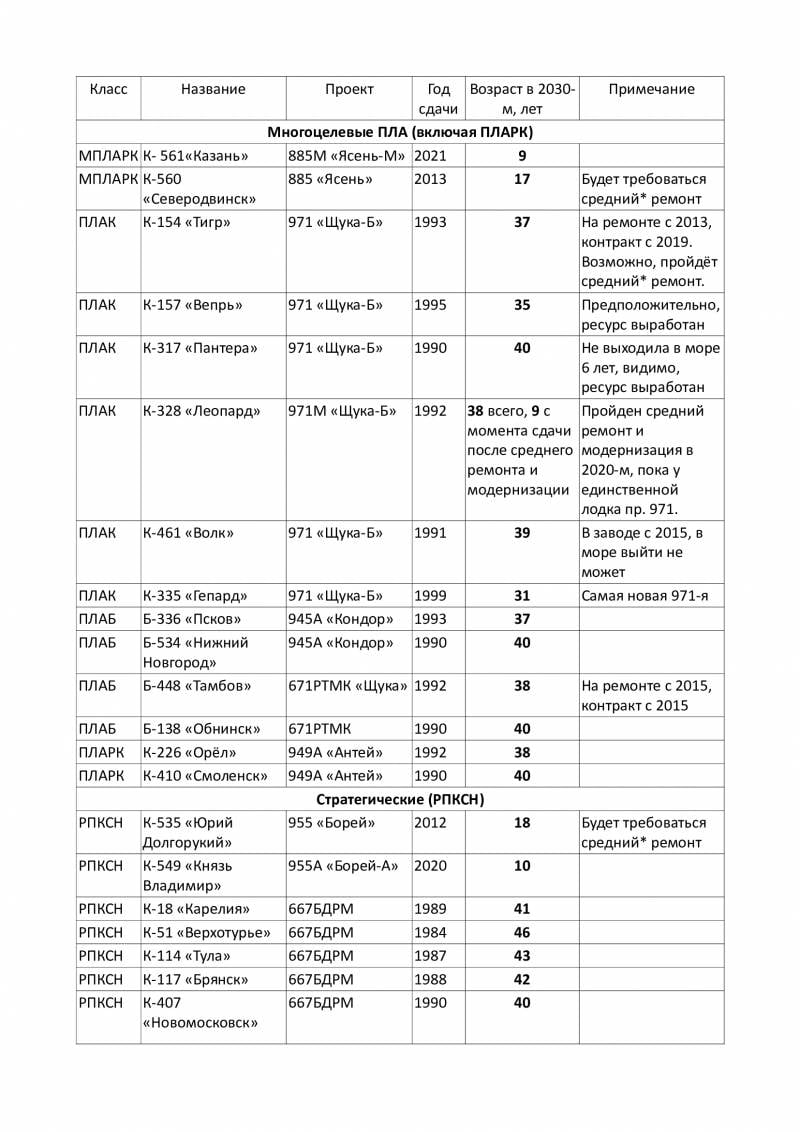
* Medium repair - repair in the middle of the assigned service life. Timely (key word) passage of the average repair is critical in order for the ship to reliably and without restrictions leave the entire period assigned to it.
The plate looks big and it seems that it is necessary to press on with the repair and that's it, but no - it won't work. But it is guaranteed to push only with the "Cheetah", the boat is relatively old, if you send it for medium repair in 2022-2024, then by the time of war it will be in a combat ready state.
The rest of the ships had to be pushed in 2009–2014, when there was money, there were no sanctions, and the ships were not so tired. But the passage of medium repairs and upgrades by third-generation submarines was deliberately disrupted by the responsible persons from the Military-Industrial Commission, the Ministry of Industry and Trade and the Main Command, in order to "open the way" for the mass construction of "Ash trees", which were supposed to replace the entire "third knee" (according to the apt expression of one of these "responsible": "the third knee must bend"). This was not necessary for the sake of defense capability - just some comrades wanted to push through the "Ash" because they had not done anything else in their life, others wanted to master the budget on this. And they mastered it.
You can briefly read about this in the article by the author. "How the plans to increase the power of Russian submarines arose".
Therefore, it is absolutely inevitable that all these 30+ boats will be decommissioned. By 2030, out of the 3rd generation, only the Leopard, which has undergone a full-fledged medium repair with modernization, will remain in service.
Of course, a miracle can happen, the Navy will show strong-willed super-effort, and the K-335 Gepard and K-154 Tiger will also go through the same upgrade as the Leopard.
Then we can assume that from the current composition of the Northern Fleet's nuclear submarines, Severodvinsk, Kazan, Leopard, with Gepard, Tiger, Yuri Dolgoruky, Prince Vladimir ".
Everything else, even those that are currently undergoing repairs (not average, but HTG - restoration of technical readiness), will be written off.
Of the four mentioned, "Leopard" and "Tiger" will already be "on the brink" - you cannot deceive the age, if the boats are able to fight, then a lot of restrictions will be imposed on them, for example, in terms of diving depth. "Cheetah" - depending on the average repair, without it it can even be written off.
Well, we will repeat, with the "Tiger" it is unlikely, most likely, its average repair is in question.
Did the responsible statesmen succeed in replacing them with "Ash"?
We are looking at what is being built for the Federation Council today.
As you can clearly see, no. Did not work out. And this was clear even when the third generation modernization project was being killed.
This is what the final composition of the Northern Fleet's nuclear submarine forces will be in 2030.
Optionally, the "Tiger" may survive until this date, but this is unlikely for many reasons. It just started to be repaired too late, most likely, “it will not work like a Leopard. Nevertheless, there are still chances.
It is easy to see that for five "strategists" we have six boats capable of covering them (we do not take into account the old Leopard here, even if the boat is still in service, the Tiger, for obvious reasons, too). If we assume that the Navy will act "as usual", then most of the Yasenei-M will be tied to the protection of SSBNs. One can argue about the need for such, but we have no other doctrine of the combat use of submarine forces.
And this, in turn, excludes any offensive actions at sea, even when they are critically needed.
Now let's look at the Pacific Fleet in 2030.
What have we got with the atomic submarine?
So now:
By the way, it is worth digressing here, asking a question to the "hurray-patriots" who usually foaming at the mouth prove that everything is being done correctly in our country, and the author "throws mud at the achievements of Russia."
Guys, are you okay with achievements?
One running multipurpose boat 971 of the project and a pair of "batons" 949A for the entire Pacific theater of operations, for example, is this normal?
Is this such a symbol of our greatness?
Do you want to give a couple of reasons why this is the way it should be?
Let's go back, however, to the numbers.
We again have an outwardly large sign, but which of it is guaranteed to live until 2030?
Only Irkutsk is guaranteed, and its condition by this year will probably be like the Leopard, that is, the boat is combat-ready, but possibly with limitations, for example, in depth (or maybe not).
Kuzbass will definitely be written off from the multipurpose ones. He now serves alone for the entire fleet, it cannot go for nothing, by 2030 the boat will be decommissioned.
Of the remaining three 971s, one unit with the highest possible probability will go to India, apparently, K-295 "Samara" or K-331 (formerly "Magadan", but this is less likely), two that have been repaired will remain, but their status in 2030 depends on what kind of repairs will be carried out there. If technical readiness is restored, then they will have to be written off guaranteed by this year. If "like a Leopard" or a well-made average repair, albeit without modernization, then by 2030 the Pacific Fleet will have two running and relatively combat-ready "Pike-B".
In the case of "only medium repair" - with old torpedoes and unusable, hydroacoustic countermeasures, without anti-torpedoes, but, for example, with anti-submarine missiles and mines. Well, even so ...
Such a boat cannot win a duel with "Virdizhnya" or "Taigei", but you can sink a ship or place mines while no one sees. Well, of course, he can get lucky in battle.
All this does not apply to the "Borey", of course, it was about the submarines of the general purpose forces. Boreas are new, they normally reach 2030, as in the North, but then they will need to be repaired.
And what is being built there?
Well, just like in the case of the Northern Fleet, let's summarize.
It is easy to see that even taking into account the miraculously preserved 971s, the Pacific Fleet, like the Northern Fleet, does not have enough strength to attack and defend the SSBN. At the same time, we keep in mind that if Samara and Bratsk receive not average repairs, but HTG, then by 2030 they will be guaranteed to be written off, and they will not be on the plate, and only five boats will remain - four Yasenya-M "And 42-year-old" Irkutsk ".
And, of course, it will not work to allocate submarines to disrupt the American strike while maintaining the requirement to cover the deployment of SSBNs.
Here we need to remember something else as well.
About the fact that Ash has "dead" means of hydroacoustic counteraction.
About them in the article by M. Klimov "Anti-torpedo catastrophe". About the fact that there are no anti-torpedoes, and in general the boats were surrendered with imperfections. About the incomprehensible situation with the "Physicist" torpedoes and the lack of modern telecontrol for them. Again, you can recall a number of materials on "Ash", for example,
"AICR" Severodvinsk "surrendered to the Navy with critical deficiencies for combat readiness",
"Pitfalls" "Severodvinsk-M" (APKR "Kazan"),
"Anti-torpedo disaster" of the Russian fleet.
At one time, the author published an article “Fleet without ships. Russian Navy on the verge of collapse ", which caused a certain resonance, up to the introduction of money for a refutation article to one stupid blogger. They turned out so-so.
And now the time has come, and we see - the fleet seems to be as it is (in any case, finances have been mastered oh-ho), and there are almost no submarines in it. The collapse is obvious, moreover, the surface forces are the same.
In 2030, Great Britain will either have parity (if the Cheetah and Leopard remain in service), or superiority in the number of nuclear submarines over the Northern Fleet. One or two units. With the superiority of "Astyut" over "Ash-M" in the underwater weapons and stealth.
Even Australia, according to the published plans of the Anglo-Saxons, should have eight multipurpose nuclear submarines by 2036. And the Pacific Fleet will have from four (excluding 971s) to six, plus the seventh - "Irkutsk". The enemy again has both quantitative and qualitative superiority, and again he has it without the Americans (if Australia succeeds, frankly speaking, there may be difficulties there).
So it turns out that a kind of anecdotal project of global Britain is gaining numerical superiority over Russia in nuclear submarines, even without the United States. While maintaining quality.
And, together with the United States, the ability to crush our country with a sudden, disarming nuclear strike.
I would like to ask those who have been behind our shipbuilding policy since the 2000s: “Gentlemen, what was that all about? Stupidity, or is it intent? "
However, there will be no answer. Although some people worked for this very result quite consciously.
Were there other options?
The RF Ministry of Defense has long and consciously embarked on a policy of refusing to urgently correct critical shortcomings in the combat training of the Navy and naval development, preferring to flood everything with propaganda. It is difficult to say why, but the Ministry of Defense is ready to spend more on show than on real combat training - just not to solve real problems. This is often not the case in the Ground Forces, sometimes it is not so in the Aerospace Forces, but it is almost always the case in the Navy. This is precisely the principled approach: “We will not prepare for war anyway, so that you don’t shout from below, okay?”
But the Defense Ministry's propaganda machine will certainly be set in motion. And, as soon as the people realize the meaning of the numbers given in the tablets, then, without fail, through hired bots and controlled forums, the thesis will be thrown into society en masse that, they say, yes, there are few submarines, but the economy simply does not allow it anymore.
Due to the seriousness of the issue, this lie must be crushed in advance, at birth.
So, let's look at whether it was possible to take somewhere not only money, but also building places?
Oh yes, and haven't we lost the "extra" submarines somewhere yet?
First, let's deal with the latter right away.
As you know, PLASN "Belgorod" - the second after "Sarov" carrier of nuclear torpedoes "Poseidon", was launched recently.
We can safely say that this "Belgorod-Poseidon" link will never be used for its intended purpose - given the weakness of the general-purpose forces, the boat with mega-torpedoes simply cannot reach the launch point (they cannot be launched anywhere). Some Virginia or Seawolf will shoot her. Or Astyut, or maybe Taigei.
And the super torpedoes themselves are a pointless thing. They are quite intercepted along the way. That is, if we now invest billions in the combat stability of Belgorod, then ... nothing. That he has time to shoot with Poseidons, that he does not have time - the result will be the same.
Completely meaningless system.
For those interested in the question, but who missed the analysis of "Poseidons" - a few materials.
A. Timokhin. Poseidon Atomic Drone: A Useless Superweapon.
M. Klimov "Status" dead end ".
M. Klimov "SPA Poseidon" / "Status-6". To the detriment of real defense capability ”.
But this whole feast during the plague cost us one Project 949AM submarine, from which the Belgorod was built! Unlike our usual "loaves" and even the modernized "Irkutsk", "Belgorod" immediately implemented a lot of solutions to reduce noise. This boat would have come out of the building with the ability to use the Caliber and Onyx missiles. Equipped with anti-torpedoes, which was quite possible, and modern torpedoes, this boat could have won a battle that would have started with a sudden torpedo attack against it "out of nowhere."
And the rockets would be very useful in strikes on the coast, and would become a factor that the "partners" cannot ignore.
This boat is now lost, turned into a gigantic and insanely expensive toy for the GUGI, which simply cannot technically function as intended.
So, here is one lost submarine, here is one construction site occupied by her killing as a full-fledged combat unit, and here is all the money spent on it.
Few?
Okay, let's continue.
Khabarovsk is another nuclear submarine being built for the GUGI for the Poseidon system, another useless waste of everything: from money to metal. Another lost opportunity to build something worthwhile on this place and with this money. At the cost of "Khabarovsk" and saws on a nuclear torpedo, it would be quite possible to build another "Ash-M", no matter how many disadvantages this submarine has, and even this is better than none. And you would have had time! And there, you see, they would try to eliminate the shortcomings ...
So, here's the second sub, the second build site, and the money spent.
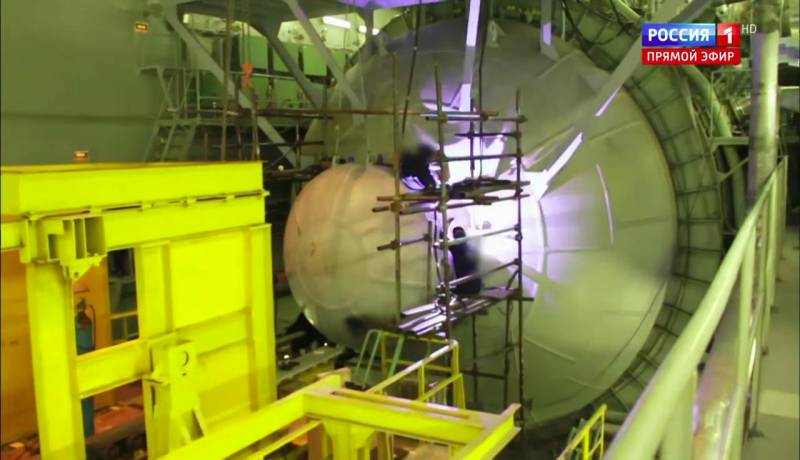
The presumably strong hull of the Khabarovsk submarine under construction, pr. 09851, in workshop No. 50 of the Sevmash Production Association (frame from the video shown in the State Duma on 01.03.2018/XNUMX/XNUMX). Source: militaryrussia.ru, DIMMI blog
Two lost submarines were found.
All?
No.
We look at the photo.
What is there in the boathouse of the Amur Shipyard (ASZ)?
Yeah. 971st "Pike-B".
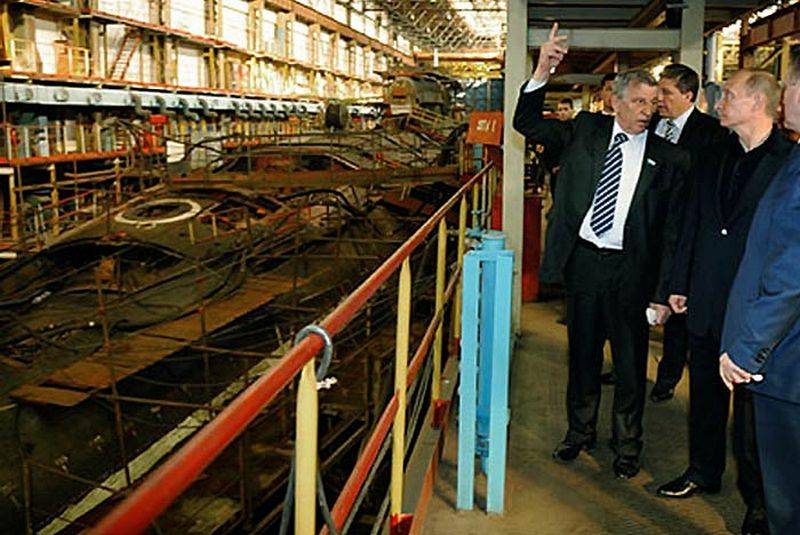
 Source: premier.gov.ru
Source: premier.gov.ruWhat is she doing there?
Yes, the place has been occupying for many years, either at 40 or at 60 percent readiness. This is the last boat in the series - "Irbis", aka "519th order". And no one needs it, this submarine, although this unit can be completed in a modernized form, with the elimination of some of the inherent flaws of the 971 project in terms of stealth, with modern hydroacoustics, new weapons ...
Yes, she will have to "implant" something from "Ash-M", so what, isn't it possible? Is it bad?
Moreover, a huge amount of work on the boat has already been done. The project has someone to do, SPMBM "Malachite" is alive and well.
Yes, NEA is now clearly not in a position to complete this project on its own. But he is included in the USC! As well as "Sevmash".
USC that cannot temporarily maneuver with specialists and material resources? Why, then, is such an ineffective structure needed?
The third submarine was found. And the place.
And most of the money has already been spent on it, of course, they are also needed to complete the construction, but would our country not have financially mastered this separately?
But nothing is done, the boat continues to stand.
I wonder if it will turn out that they will begin to cut it right before the American strike from under the water?
The cognitive dissonance of the surviving carvers will be especially strong in this case.
Few?
No question, now there will be more, but for now we will ask the Ministry of Defense and the supporters of the "party line" questions - this is all before the Third World War, what is this? Is this how it should be? And if so, why, for what purpose are all these, to put it mildly, tricks arranged?
Moreover, these are very expensive and resource-intensive tricks!
In the meantime, we will fix the answer to the theorists of financial insufficiency: for the money spent on toys - we would have one noiseless and armed "all the way" "loaf", another "Ash-M" would be completed, and yes - "Irbis" is also nowhere from the Amur the plant has not disappeared. So you have no money. So much for the industry at its limit.
And the GUGI could easily have done without these two submarines, they were needed only for "hitting" at nuclear torpedoes, the other tasks of the GUGI are solved without them, in extreme cases, the decommissioned SSBNs of the 667BDRM project have not yet been cut, from this "raw material" of boats for the GUGI it is possible "Rivet" as much as you like on the model of the submarine "Podmoskovye".
But we will continue.
Medium repairs, titanium cases and upgrades
To understand what went wrong, it is worth understanding the concept of "average repair" in relation to nuclear submarines.
This repair is called “medium” because it is carried out in the middle of the ship's life. For each project, the development organization has determined a list of works that should be part of the mid-life repair. Alas, in the main, instead of the repairs stipulated by the regulatory documents, the so-called "restoration of technical readiness" is carried out - VTG, about which the general designer of project 949A and other ships of the Central Design Bureau "Rubin" IL Baranov wrote:
Taken hence.
Here it is necessary to say the following - HTG needs to be streamlined and legalized, formulating such requirements for their implementation, which would allow solving the problem described by I. L. Baranov, and prescribing them in regulatory documents. Then, the old boats that have undergone medium repairs can be “run” through these new high-temperature turbines closer to the end of their service life, and ensure that they remain in service and combat-ready throughout the dangerous historical period in the first half of the 2030s.
The Soviet-built submarines listed in the tables - projects 971, 949A, 945A and 671RTMK did not receive medium repairs and continued to pass mainly HTG. This is a completely different scope of work. After undergoing a medium repair, the service life of the submarine is usually extended by ten years, and after HTG - by three.
Medium repair is an excellent reason for modernization, since at this moment a very large number of ship systems are dismantled in accordance with the repair technology, and if there is a ready-made modernization project, it can be performed together with a medium repair almost without additional time investment.
This is exactly what was done with Leopard and Irkutsk. And this is exactly what was not done with the rest of the submarines.
That is why "Leopard" and "Irkutsk" will meet the thirties in the ranks, and with their more or less moderate use, they will also have minimal or no restrictions.
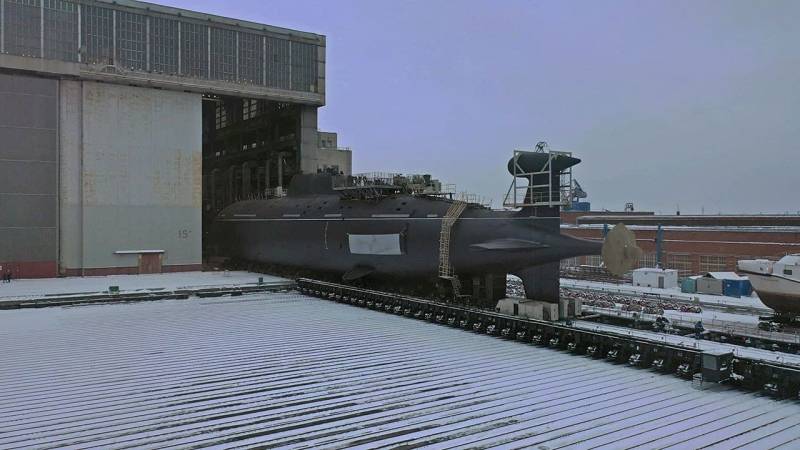 The Leopard is being taken out of the boathouse. So far, this is the only boat of the 971 project with a mid-range repair and modernization. Photo: TV channel "Zvezda"
The Leopard is being taken out of the boathouse. So far, this is the only boat of the 971 project with a mid-range repair and modernization. Photo: TV channel "Zvezda"What will limit the lifespan of submarines that have received average repairs?
Firstly, the state of the trunk cable routes - they do not change during average repairs, as this will make its cost prohibitively expensive. Their lifespan is about 40 years. Extending the life of cable routes is accompanied by enormous difficulties and minimal gain - in a matter of years.
The second thing that will limit the life of the submarine is the condition of its solid hull. The hull is under severe stress when the boat is submerged, and in the case of deep diving, they are especially great.
We will also give a little-known fact to the public - for a submarine, not only the maximum depth and working immersion are normalized, but also the time spent on it. The loads are so great on a solid case.
Accordingly, the service life of boats that underwent medium repair and modernization on time would be limited by cable routes and hulls. It can be more or less confidently assumed that almost all third-generation boats would have to be written off at about 44-45 years of service, due to the fact that it would no longer be possible to repair cable routes and guarantee the safety of diving.
Now let's look at the tables above.
In 2030, out of the entire third generation, which is in service today, only seven submarines in two fleets would come close to this age, the rest would have to serve for another 7-10 years (excluding SSBNs). And this means that they would have entered the world war of the mid-thirties still in a combat-ready state, but, apparently, they would not have been able to dive too deeply.
Failure to modernize and repair the third generation nullified this possibility.
The second problem is that carrying out a full-fledged medium repair with modernization would allow to "cheer up" ship repair to such an extent that by the time of the medium repair of the Ash, this industry would be able to provide it - and now this is far from a fact, boats are "problematic »In terms of repairs, with a very tight layout and poor maintainability.
The need to provide average repair of all Ash trees within one ten-year period (since almost all of them are rented out within one ten-year period) will become a most difficult challenge for the domestic industry, which will definitely not be ready for it. And I could have prepared in the third generation.
However, it is possible that they will all be overheated, and they simply will not need medium repairs, but it is impossible to make plans for the development of the fleet on such a probability!
Link to the article "How the plans to increase the power of Russian submarines arose" has already been given, but it is not a sin to repeat it.
Why was the repair program “hacked”?
Let's repeat - to master the budgets on the super-expensive "Ash".
And no one thought that there was a mass of useless or dubious expenditure items, the reduction of which would have given the necessary funds - from patrol ships of Project 22160 and further to the Poseidon nuclear torpedo.
Let us fix, therefore, that by the time of the possible start of the next war, we could have much more submarines, without a significant increase in the budget.
Reducing the series 22160 and 20386, we get at least four ones, which can still fight in the mid-thirties, and together with the mutilated and lost military significance "Belgorod", "not happened" boat instead of "Khabarovsk" and "Irbis" - already plus seven. And - within the same budget, without increasing costs! Or almost no increase, we agree.
Clever militarism is inexpensive.
And if you add just a little, cutting down on some other things, such as naval parades?
And if so, then there were other options, albeit more expensive, but also more interesting, quite feasible for the country. Let's take a look at them.
Let's go back to the cable routes first.
If they so limit the life of the submarine, then maybe they can be changed?
In fact, it is unprofitable, the cost of replacement is enormous and under normal conditions does not justify itself, and in this case it is really better to write off the ship.
But this is under normal conditions.
And in the pre-war?
And in the pre-war - on the contrary.
Even if we assume that the replacement of cable routes on one boat costs as much as a quarter of the construction of the same new one, then this means what?
This means that for the price of one boat, we will receive four in the combat strength. Just a little outdated. Moreover, if this is not done, then this one new boat cannot be built with the proceeds - there is nowhere. And there is still where to replace the cable routes.
But here the problem of a small residual resource of durable hulls arises - there is nothing to be done with them, right?
True, with one exception.
The Russian Federation has at its disposal not only steel submarines, for which everything described above is true, but also titanium submarines, projects 945 and 945A. The first of them have already been withdrawn from service. In the early 2010s, they wanted to modernize them along with the rest of the third generation, and then they were sharply "wished for" ("Ash trees", "Poseidons"), and the boats are now "in sludge". Two 945A are running, and by 2030 they will be written off "along cable routes" and the general technical condition, since they did not receive an average repair.
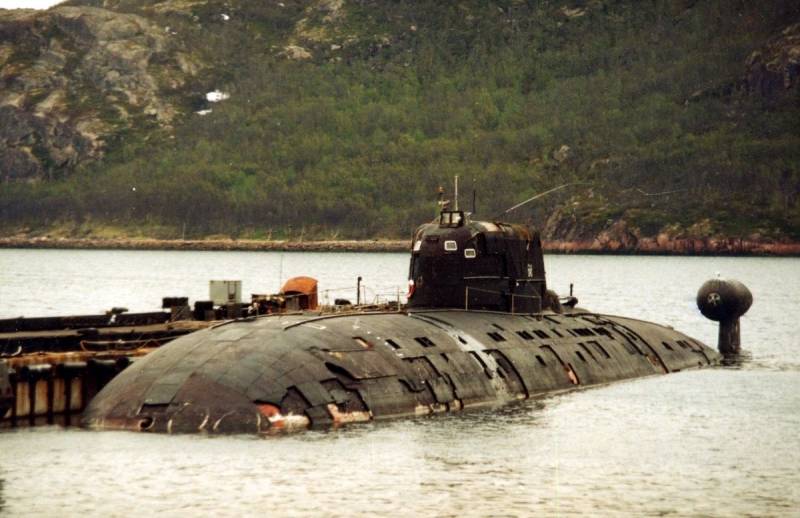
PLA B-276 "Kostroma" of project 945 in "sludge". This boat, like the other 945th - B-239 "Karp", has already been withdrawn from the Navy. But titanium cases last a very long time.
What are the specifics of titanium boats?
In strength.
Their robust housings can withstand loads much better than steel ones and have a significantly longer service life. And here we are suddenly faced with another situation - now the pre-war replacement of cable routes on the boat, albeit very expensive, but justified by the receipt of a combat unit, is not depreciated by the state of the strong hull, because this state allows the boat to serve for many more years.
Open sources indicate that all titanium submarines had to be upgraded. None of them underwent even average repairs. But the developer of "Ash", SPMBM "Malakhit" in some incomprehensible way was able to take possession of the rights and documentation for these boats, apparently with the help of some important and even respected "state" figures, "wringing" the rights to "Lazurit" own submarine.
It is for the sake of no modernization, but would be almost trillion (in the future, when "Ash" still have to finish, eliminating their shortcomings) the cost of a series of Malachite monsters - not without the flow of some of this money into the pockets of important, respected and state, of course.
And here we need to make two reservations.
Yes, even the third generation boats that have undergone medium repair and modernization would have to be written off in the mid-thirties. Perhaps they would have made it to the war, and probably not, or they would have made it with operating restrictions. Part would have had time, of course ...
But the "Barracudas" and "Condors" could well not just be repaired and modernized, but rebuilt to a high level of combat effectiveness, precisely because of their hulls. For a cost comparable to one Yasenem-M, you can get four boats comparable to the Yasenem-M, albeit somewhat inferior in a number of features. And by the beginning of the war they would have done it - without imposing restrictions on the boats.
Yes, there is also the issue of the resource of the main turbo-gear units - GTZA. But you need to deal with it, which is called individually. In any case, the "Zip" GTZA will be in stock after the write-off of a number of submarines. In general, we will restrict ourselves to the fact that this issue is solvable.
This is roughly what was “blown into the wind”. In the pre-war years, recall the years. Every time now or later, when everything happens, corrupt online workers from bot farms will write to you on the Internet that there was not enough time for preparation, the economy did not allow - remember how it really was there. Because if at least something remains of the Russian Federation, and at least one of the current ruling class retains at least some influence, then all of the above will be hidden by all available means.
And now we turn to the most important thing - these titanium hulls have not gone anywhere, and it is with these boats that nothing is lost.
"Titanium fish" for the third world
This last failure - the refusal to modernize project 945 and 945A titanium submarines - should be the starting point.
We cannot build anything other than what has already been laid down - there simply will not be enough time.
The resources of 971 projects are limited, and if some of them will be able to survive until the mid-thirties, if they receive medium repairs and upgrades, then that's it. If a war breaks out in 2036–2037, at best they will be on the verge of being written off, and most likely already written off, leaving behind only a "revived" ship repair.
With the modernization of the "loafs" of Project 949A, Russia is basically completely late, moreover, we need ships that can conduct offensive operations in different conditions, cruising submarines.
There are no new budget projects that could be started to build right now.
Project 545 Laika - it will be a tragedy worse than the Ash, and obviously this ship will not be in time by the start of the war, and as a result, the inadequacy of this project will become clear not only to specialists, but in general to everyone - the boat, in fact, repeats the ideology “ Ash-M ".
But titanium cases are a chance. The opportunity to get four relatively good multipurpose submarines by about 2030 is a plus to the composition that is guaranteed to be in service today by this year.
Most importantly, to rebuild boats, it is not necessary to use the factories where the boats are built, everything can be done at repair factories. Moreover, all subsystems can be taken from ready-made projects.
Four cruising submarines are four cruising submarines: if the surface forces and aviation will be able to disorganize the enemy's anti-submarine defense, or if it is possible to competently introduce submarines "into action" before the outbreak of hostilities, then they will become a serious force of great importance.
And most importantly, after such a restructuring, they can continue to serve for many years, for example, if the war does not happen after all, or if they can somehow survive it. This does not mean that they will have to be kept in service forever, after all, this is precisely a "pre-war" decision, but then they can be changed later quietly, without haste, planning new boats without such violence over the economy, which became the series " Ash-M ".
And of course, on the eve of the average repair of the Yasenei-M after 2035, the restructuring of the four titanium submarines will be an excellent training session.
The question arises - where to get additional money for all this?
The sums there will be considerable, apparently, for four submarines rebuilt in this way, several tens of billions of rubles will have to be paid, that is, the cost of "Borey-A" and higher.
There is an answer - it is necessary to finance the subject of the Poseidon nuclear torpedo and start cutting the budgets of PR events such as the main naval parade in St. Petersburg. Then it will be much easier to finance the submarines.
There is still the question of "Khabarovsk", the construction of which also requires a lot of money due to the uniqueness of its equipment (this is the carrier of the deep-sea stations of the GUGI) and weapons (SPA "Poseidon"). Generally speaking, it can simply be frozen, and that's it, and the money saved can be used for the projects listed above.
There is only one exception - if it is possible, using the reserve of "Khabarovsk", to redesign it into a multipurpose submarine and build it in this capacity.
It is not at all a fact that it is possible, and it is not at all a fact that it is rational for financial reasons, even after adjusting for the pre-war time. But this issue needs to be worked out.
And if this option is not rational, then just stop the construction site and deal with this boat sometime later, when the tension in the world decreases. Maybe a sturdy case will do something later someday.
What other options are there?
Scraping out the last or Indian reserves
What else can be done?
First, stop preparing the handover of one of India's boats. Obviously, the Indians are given a boat with the best cable routes and a solid hull, which will be able to sail a year until 2033 at least.
You need to keep it for yourself, and, having modernized it, return it to the combat strength. India should be offered ... the construction of "Ash-M" at its shipyards. Such a decision will bring a lot of money, for the sake of transfer such The Indians will do everything, including political concessions, which are very important before the war, and domestic suppliers will in any case earn on this construction the same way as on the construction of Yasenya-M in Russia, or even more. Russia does not lose anything here, the concept on which the 885M project was invented is no longer relevant, in the future, in order to deal with anti-submarine defense, completely different boats will be needed.
At the same time, we can safely assume that the harsh formulation of problematic issues on the part of Indian sailors will force SPMBM "Malachite" to bring its offspring "to mind."
But by 2030 we will have another boat, which, perhaps, normally reaches the war.
All?
No.
There is also another Indian boat - "Chakra", she is "Nerpa". To date, the Indian Navy has returned it to Russia. This event was reviewed by M. Klimov in his article "Submarine" Chakra "is going home. Achievements and Challenges of Our Underwater Export ".
It is difficult to say in what condition the submarine is now - on the one hand, the Indians very carefully watched the nuclear submarines that were previously transferred to them. On the other hand, for some reason it was returned, and its operating conditions were much tougher than those of Russian nuclear submarines. But we can safely assume that if the Nerpa is capable of being repaired in principle, then it can be returned to service already in the Russian Navy.
Of course, you need to carefully examine the solid hulls of all available multipurpose submarines, even those that have already been decommissioned (the same project 945 has been withdrawn), perhaps there will also be candidates for the "resurrection of the dead." And then they also need to be “put in line”.
However, if it does, it is pure luck, and it is impossible to make plans for it.
Results. We find lost boats, and in general
We summarize.
If in peacetime it is required to build up military power strictly rationally, then in the pre-war time it is necessary to slightly shift the emphasis and rely on the growth of military power even in the absence of budgetary savings in this process: if only the power was real, and not “Potemkin villages, it’s expensive”, as it is now.
It so happened that due to the "pushing" by dishonest people of super-expensive "underwater battleships" of the "Ash-M" type (albeit without "armor" - anti-torpedoes, and with problematic "shells" - torpedoes), new submarines by 2030 our Navy will have only nine units, plus a couple (if the Tiger is saved - three) modernized ones. Against the United States, Great Britain and possibly Australia (not counting their allies' non-nuclear boats).
A less expensive and complex project, and even more effective in underwater combat than the "Ash-M", and suitable specifically for mass construction, in our country did not even appear because of this error.
But there were prerequisites.
Just a quote from an article (2005) by the chief designer of the 677th project, Yu.N. Kormilitsyn:
Applying the method of constructive transformation at the stage of the technical design of a diesel-electric submarine in 1977, we proposed to create on the basis of its block modules a small multipurpose nuclear submarine Un = 2500 t. Since then, CDB MT "Rubin" together with leading institutes and enterprises of the industry as well as by the specialists of the Navy, it is constantly developing this direction.
The concept of military-economic efficiency based on the method of constructive transformation makes it possible to achieve significant financial savings both at the R&D stage and in the preparation of production and construction of submarines. At the same time, a small nuclear submarine can be built in parallel with a basic non-nuclear submarine at the same shipyard, using a single technology, using one technological equipment. Taking into account the principle of basicity in the formation of submarine forces, convenience for the training of crews is provided, and the operation of boats is simplified and made cheaper. "
And further -
Link.
You can also cite as an example the article by M. Klimov "Does our fleet need a small multipurpose nuclear submarine?", which provides a number of justifications for the need for such boats right now.
That is, there were options to build a large and efficient, but inexpensive fleet, they were calculated. But on my mind were only "Ash", or rather, their price tags.
Medium boat repairs and upgrades, which would have made the fleet more numerous in the first half of the 30s, were also slaughtered so that there was enough money for new submarines - of which, as we found out, there are nine in total.
The results can no longer be hidden.
In these conditions, taking into account the pre-war time, it is necessary to do the following:
1. To carry out the completion of the submarine "Irbis" in a modernized form. The scope and direction of modernization is a topic for a separate conversation, for now we will restrict ourselves to the fact that it is necessary and possible. One boat.
2. For the leopard submarine being handed over, set limits on the depth of immersion and other loads right now, in order to provide a durable hull resource sufficient for conducting hostilities until 2035 at least. To develop and implement a set of measures to extend the life of cable routes, including within the framework of the "new high-temperature gas pipeline", the legalization of which urgently needs to be dealt with.
3. The categorical condition is to carry out medium repair and modernization of the K-335 "Gepard". This boat will easily serve until the mid-30s in this case, and if you keep it like a "Leopard", then to the end. It would be a crime to lose this ship, but it should be repaired in 2022-2023, the edge in 2024.
4. Rebuild all submarines of projects 945 and 945A using modern systems, with the replacement of cable routes and, if necessary, replacement or repair of GTZA. Plus four boats.
5. To study the possibility of carrying out medium repairs with modernization on other submarines of project 971, which are now in the Zvyozdochka CS and in the fleets, if it is possible to ensure the operation of such a boat with the same restrictions as the Leopard until about 2035, carry out they have medium repairs with modernization. Perhaps plus one or two boats.
6. Refuse to transfer one Project 971 submarine (apparently, the former Magadan K-331 or K-295 Samara) to India, and propose the joint construction of Project 885M submarines. At the same time, the Indians, apparently, will force us, at least on their boat, to correct the existing serious design flaws, and where their boat is, there are ours.
Plus for us - the opportunity to get the boat back into the Navy for several years. Plus one more boat.
7. To partially finance these programs, stop funding the Poseidon program, as well as the development and construction of submarines for this "weapon" (let it be considered a weapon). It is necessary to freeze the construction of "Khabarovsk" until the time when it becomes possible to redesign it into something useful, or, if possible, rebuild it into a multipurpose submarine (this is, however, unlikely). Perhaps this is another multipurpose submarine.
8. To restore and return to the combat strength "Nerpa". Plus one.
9. To work out the issue of building submarines on the basis of Project 677 with a nuclear main power plant. If it becomes possible to have time to build at least a small series of such submarines by the early thirties, then this must be done. If not ... Well, at least start the development with an eye to the future, suddenly we will be able to stay alive.
A list of submarines that are guaranteed to be in service by 2030–2035 in a combat readiness condition, subject to the implementation of the measures under items 1, 4, 5, in addition to the lists above:
PLA "Irbis", the original project 971 "Shchuka-B".
PLA B-239 "Karp", the original pr. 945 "Barracuda".
PLA B-276 "Kostroma", the original pr. 945 "Barracuda".
PLA K-534 "Nizhny Novgorod", the original project 945A, is now in service.
PLA K-336 "Okun", the original pr. 945A, is now in service.
A list of submarines that, if a number of requirements are met and the technical condition is suitable for medium repair and modernization, it may be possible to return to service (although, probably not, alas):
PLA K-154 "Tiger", the original project 971 "Pike-B".
PLA K-295 "Samara", the original project 971 "Shchuka-B".
K-331 former "Magadan", original project 971 "Shchuka-B".
PLA K-152 "Nerpa", the original project 971 "Schuka-B".
TO-? "Khabarovsk" - if it turns out to be technically and financially possible to rebuild it.
Combat boats without medium repair and modernization by 2030 will have already been decommissioned, maybe the Gepard will still be sailing, but not a fact.
Thus, to one "Ash", eight "Ash-M", "Cheetah" (it is not clear only in what state), "Leopard" and "Irkutsk", which will make up our nuclear submarine fleet in 2030, excluding SSBNs , with a change in approaches, from five (one of them is new) to ten (of which two are new) multipurpose nuclear submarines can be added, as a result of which we will have not 12 submarines in two fleets, but 17-22. And this must be done without fail - a fleet without ships cannot fight against a fleet with ships, and we are being brought to this very point.
At the same time, it will be necessary to do without the construction of new "Ash-M", which the state will certainly try to impose the businessmen from the "defense" as salvation, if someone from the country's top leadership finally counts the submarines in the Navy.
In theory, of course, the country will have time to build another Ash-M. But, firstly, no more than one, and secondly, not only in the nuclear submarine fleet we have a collapse in numbers on the way, but also in the surface, and most importantly, everything is bad in the economy itself, and this is the case when have to keep without money.
All this does not negate, of course, the need to have on each submarine and modern torpedoes with telecontrol, and the latest hydroacoustic countermeasures, and anti-torpedoes. All this is very necessary, and, by the way, it will also cost a lot of money.
At first it is necessary that these things have something to bet on.
But what is definitely not needed is the construction of new SSBNs. There are already more of them than the fleet can deploy with at least minimal enemy opposition. Do not need anymore. Not a single ship.
In the next review, a similar analysis of surface forces and diesel-electric submarines will be made.
Продолжение следует ...
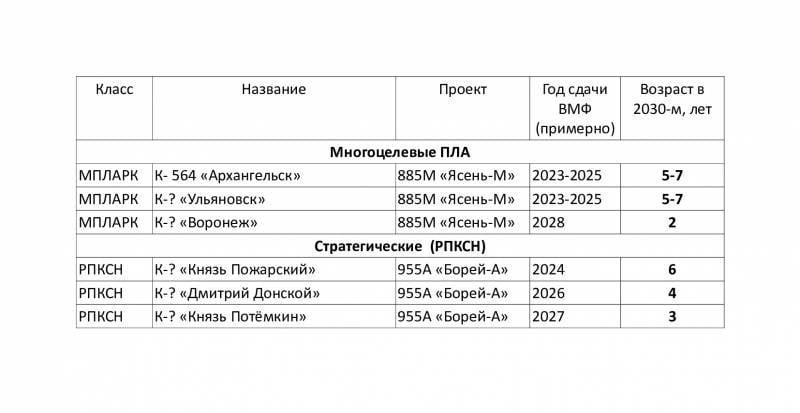
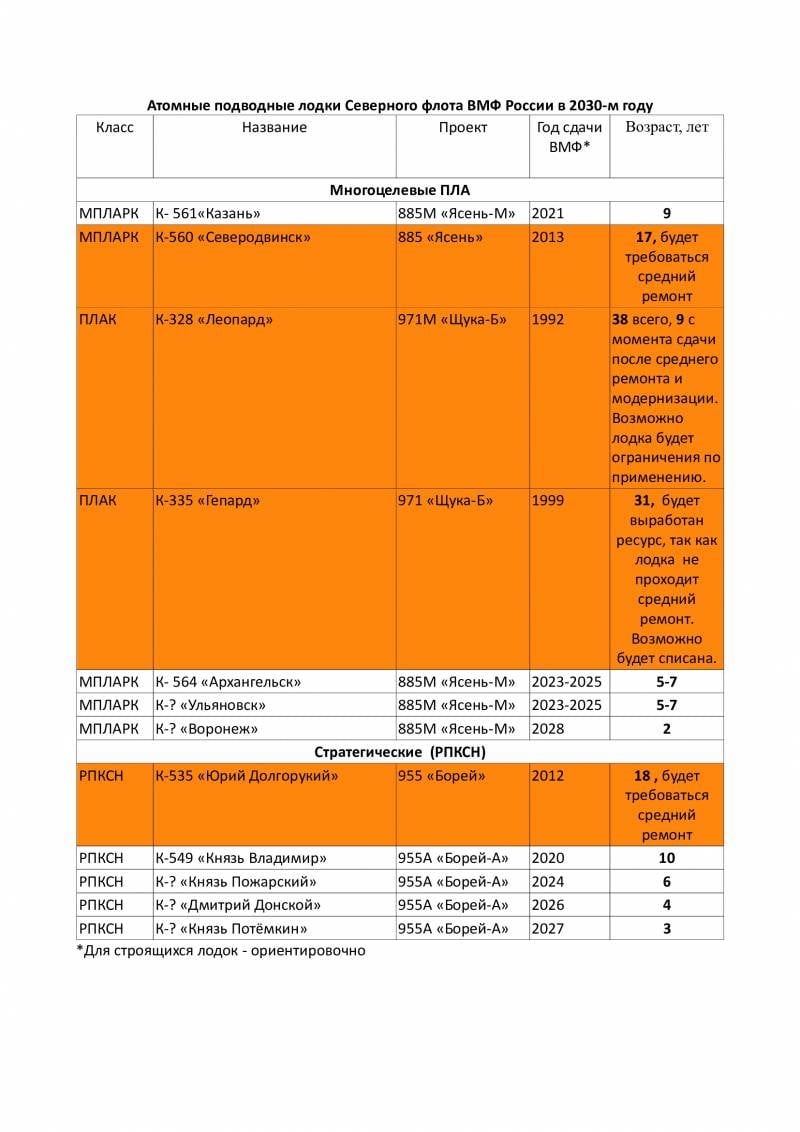
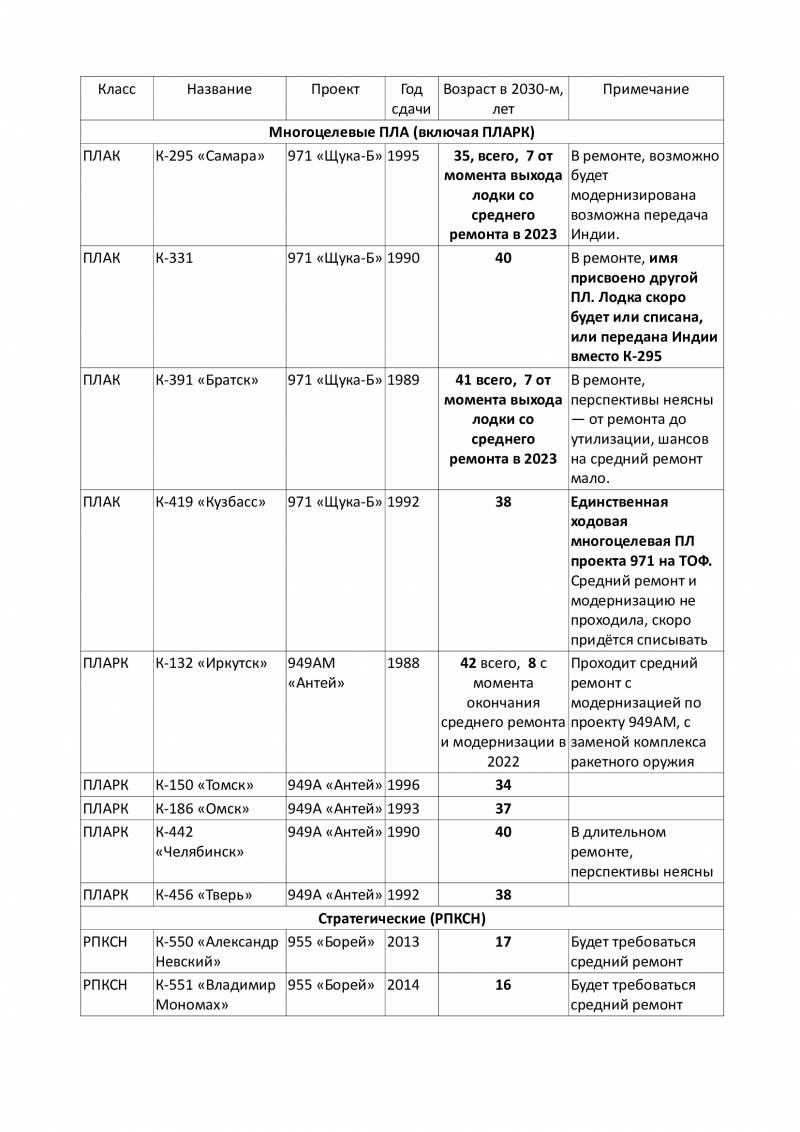
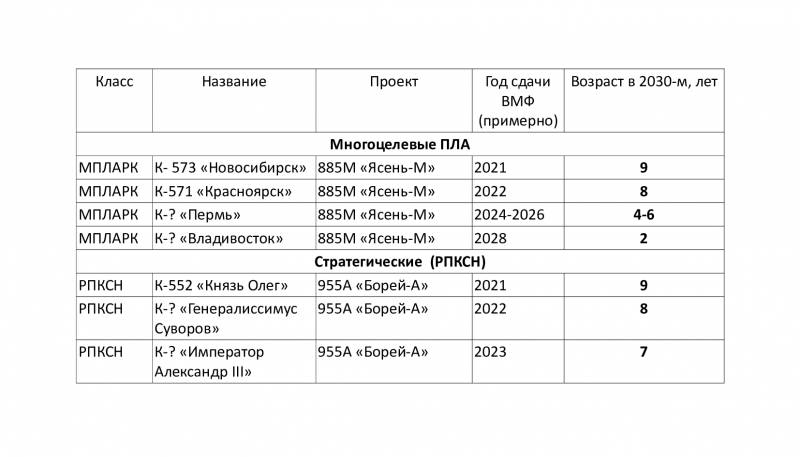
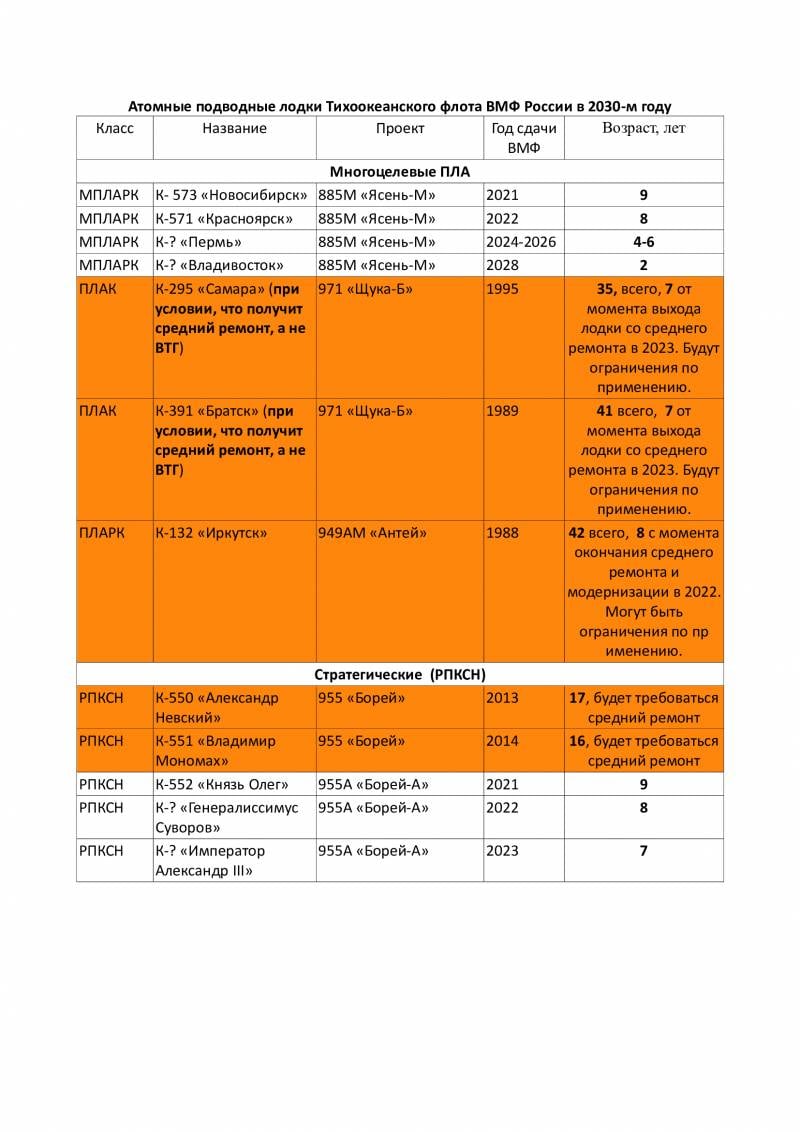
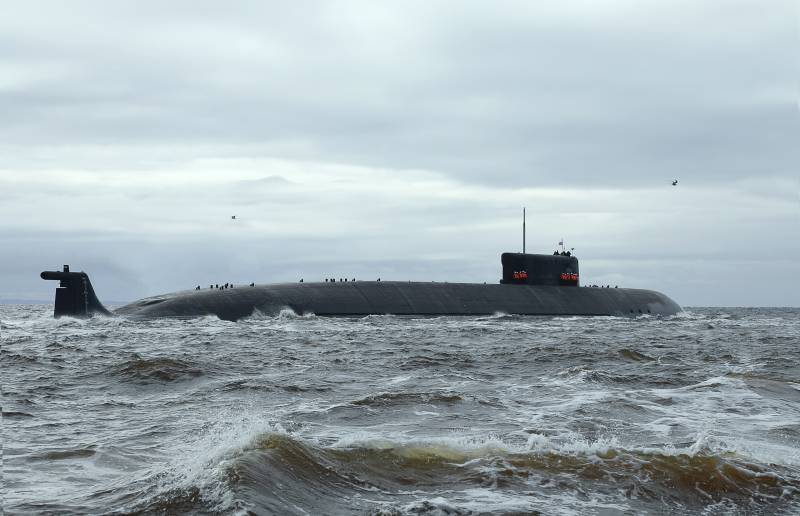
Information